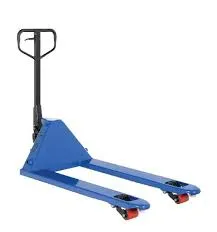


Understanding the Trolley Pallet Jack A Versatile Tool for Material Handling
In the ever-evolving landscape of material handling and logistics, the trolley pallet jack stands out as an invaluable tool. Whether in warehouses, retail environments, or manufacturing facilities, this device enhances efficiency and streamlines operations. Let's dive into the features, uses, and benefits of this essential equipment.
What is a Trolley Pallet Jack?
A trolley pallet jack, also known as a pallet truck, is a manually operated device used to lift and move pallets. It consists of a couple of key components a pair of forks that slide underneath the pallet and a hydraulic lifting mechanism. By using a pump handle, operators can easily lift the pallet off the ground and move it from one location to another. Trolley pallet jacks come in various designs and capacities, making them suitable for different environments and loads.
Key Features
1. Design and Structure Trolley pallet jacks typically feature a robust steel frame, ensuring strength and durability. The forks may vary in length to accommodate various pallet sizes, making them versatile for different applications.
2. Hydraulic Pump Mechanism The manual hydraulic pump provides significant lifting power. A simple push or pull of the operator lever allows for effortless lifting and lowering of the load, reducing the physical strain on the user.
3. Wheels and Mobility Equipped with swivel front wheels and rigid rear wheels, these jacks can navigate tight spaces and corners with ease. The wheels are often made from polyurethane or rubber, reducing the risk of floor damage while providing a smooth ride.
4. Weight Capacity Trolley pallet jacks come in various weight capacities, typically ranging from 2,200 to 5,500 lbs or more. When selecting a model, it is crucial to match its capacity with the expected load to ensure safe operations.
Applications
Trolley pallet jacks play a critical role in various sectors, including

- Warehousing In warehouses, these jacks are used to move goods from storage to shipping areas, organize inventory, and replenish stock levels efficiently.
- Manufacturing On factory floors, trolley pallet jacks assist in transporting raw materials to production lines and finished goods to shipping docks.
- Retail Retailers use pallet jacks to manage stock on the sales floor, ensuring products are easily accessible to customers.
- Food and Beverage These jacks are utilized in the transportation of goods in cold storage and distribution centers, allowing for swift and safe movement of perishable items.
Benefits
1. Improved Efficiency The use of a trolley pallet jack allows for faster and more efficient palleting of goods, reducing the time workers spend moving items and increasing overall productivity.
2. Physical Ergonomics With their hydraulic lifting mechanism, these jacks significantly decrease the risk of injury associated with manual lifting. Workers can move heavy loads without exerting excessive force.
3. Cost-Effective Compared to more advanced material handling equipment such as forklifts, trolley pallet jacks are relatively inexpensive. This makes them accessible for small businesses while providing functionality similar to heavier machinery.
4. Easy Maintenance Trolley pallet jacks generally require minimal maintenance. Regular checks on hydraulic fluid levels and wheel conditions can ensure longevity and optimal performance.
Conclusion
In summary, the trolley pallet jack is a crucial piece of equipment for anyone involved in material handling. Its combination of simplicity, efficiency, and ergonomic design makes it an ideal choice for a multitude of applications. As businesses aim to enhance their operational efficiency and prioritize worker safety, investing in a reliable trolley pallet jack is a step in the right direction. Embracing this versatile tool not only streamlines the movement of goods but also fosters a safer and more productive workplace.



